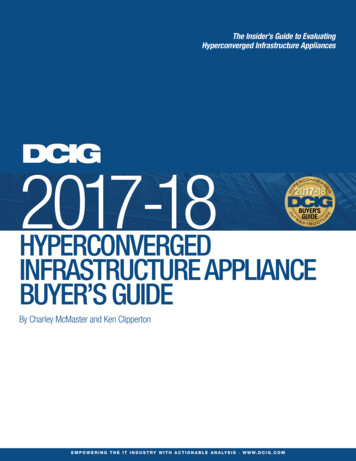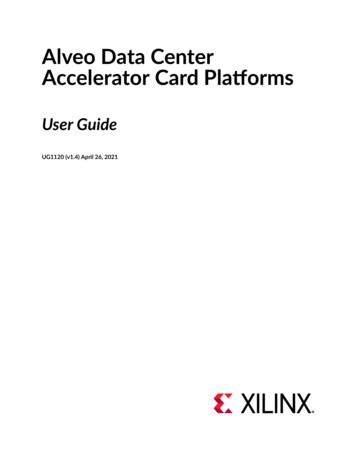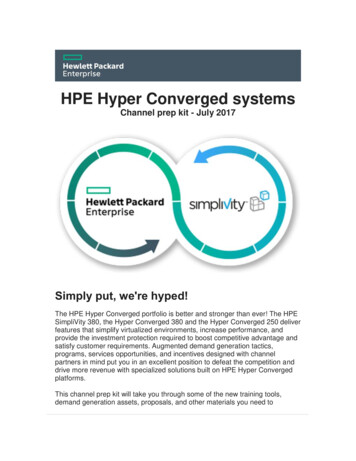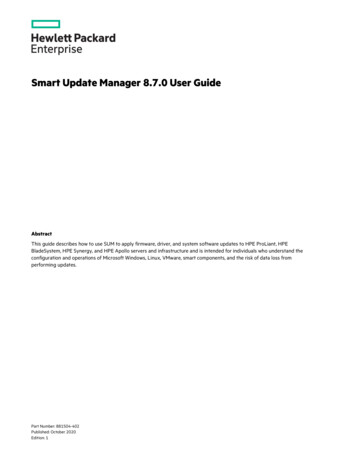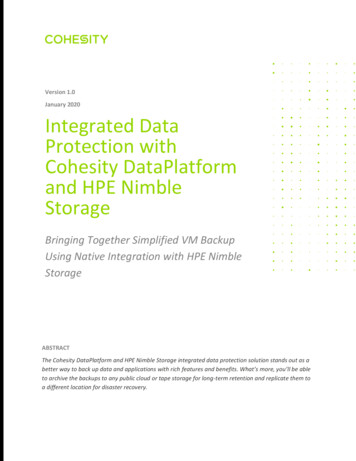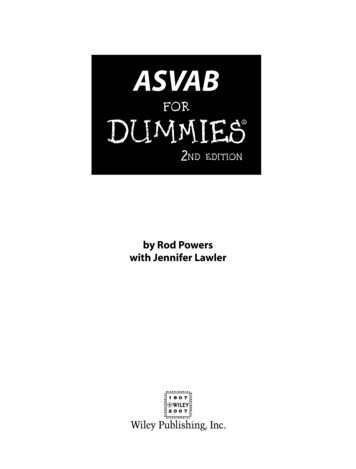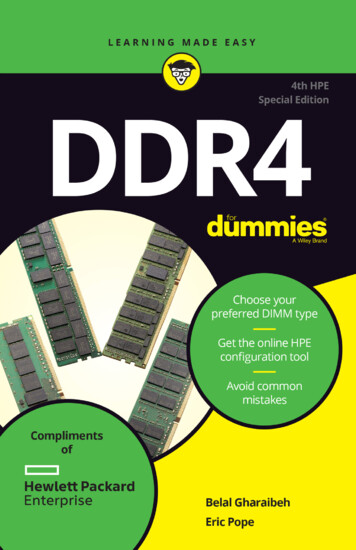
Transcription
These materials are 2019 John Wiley & Sons, Inc. Any dissemination, distribution, or unauthorized use is strictly prohibited.
DDR44th HPE Special Editionby Belal Gharaibehand Eric PopeThese materials are 2019 John Wiley & Sons, Inc. Any dissemination, distribution, or unauthorized use is strictly prohibited.
DDR4 For Dummies , 4th HPE Special EditionPublished by John Wiley & Sons, Inc. 111 River St. Hoboken, NJ 07030-5774, www.wiley.comCopyright 2019 by John Wiley & Sons, Inc.No part of this publication may be reproduced, stored in a retrieval system or transmitted in anyform or by any means, electronic, mechanical, photocopying, recording, scanning or otherwise,except as permitted under Sections 107 or 108 of the 1976 United States Copyright Act, withoutthe prior written permission of the Publisher. Requests to the Publisher for permission should beaddressed to the Permissions Department, John Wiley & Sons, Inc., 111 River Street, Hoboken, NJ07030, (201) 748-6011, fax (201) 748-6008, or online at http://www.wiley.com/go/permissions.Trademarks: Wiley, For Dummies, the Dummies Man logo, The Dummies Way, Dummies.com,Making Everything Easier, and related trade dress are trademarks or registered trademarks ofJohn Wiley & Sons, Inc. and/or its affiliates in the United States and other countries, and maynot be used without written permission. HPE and the HPE logo are registered trademarks ofHPE. Intel Xeon is a trademark of Intel Corporation in the U.S. and other countries. All othertrademarks are the property of their respective owners. John Wiley & Sons, Inc., is not associatedwith any product or vendor mentioned in this book.LIMIT OF LIABILITY/DISCLAIMER OF WARRANTY: THE PUBLISHER AND THE AUTHOR MAKE NOREPRESENTATIONS OR WARRANTIES WITH RESPECT TO THE ACCURACY OR COMPLETENESS OFTHE CONTENTS OF THIS WORK AND SPECIFICALLY DISCLAIM ALL WARRANTIES, INCLUDINGWITHOUT LIMITATION WARRANTIES OF FITNESS FOR A PARTICULAR PURPOSE. NO WARRANTYMAY BE CREATED OR EXTENDED BY SALES OR PROMOTIONAL MATERIALS. THE ADVICEAND STRATEGIES CONTAINED HEREIN MAY NOT BE SUITABLE FOR EVERY SITUATION. THISWORK IS SOLD WITH THE UNDERSTANDING THAT THE PUBLISHER IS NOT ENGAGED INRENDERING LEGAL, ACCOUNTING, OR OTHER PROFESSIONAL SERVICES. IF PROFESSIONALASSISTANCE IS REQUIRED, THE SERVICES OF A COMPETENT PROFESSIONAL PERSON SHOULD BESOUGHT. NEITHER THE PUBLISHER NOR THE AUTHOR SHALL BE LIABLE FOR DAMAGES ARISINGHEREFROM. THE FACT THAT AN ORGANIZATION OR WEBSITE IS REFERRED TO IN THIS WORKAS A CITATION AND/OR A POTENTIAL SOURCE OF FURTHER INFORMATION DOES NOT MEANTHAT THE AUTHOR OR THE PUBLISHER ENDORSES THE INFORMATION THE ORGANIZATIONOR WEBSITE MAY PROVIDE OR RECOMMENDATIONS IT MAY MAKE. FURTHER, READERSSHOULD BE AWARE THAT INTERNET WEBSITES LISTED IN THIS WORK MAY HAVE CHANGED ORDISAPPEARED BETWEEN WHEN THIS WORK WAS WRITTEN AND WHEN IT IS READ.For general information on our other products and services, or how to create a custom For Dummiesbook for your business or organization, please contact our Business Development Departmentin the U.S. at 877-409-4177, contact info@dummies.biz, or visit www.wiley.com/go/custompub.For information about licensing the For Dummies brand for products or services, contactBrandedRights&Licenses@Wiley.com.ISBN: 978-1-119-64594-8 (pbk); ISBN: 978-1-119-64582-5 (ebk)Manufactured in the United States of America10 9 8 7 6 5 4 3 2 1Publisher’s AcknowledgmentsSome of the people who helped bring this book to market include thefollowing:Project Editor: Carrie A. BurchfieldAcquisitions Editor: Katie MohrEditorial Manager: Rev MengleProduction Editor:Magesh ElangovanCover Image: Courtesy of HPEBusiness DevelopmentRepresentative: Karen HattanThese materials are 2019 John Wiley & Sons, Inc. Any dissemination, distribution, or unauthorized use is strictly prohibited.
Table of ContentsINTRODUCTION. 1About This Book. 1Terms Used in This Book. 2Icons Used in This Book. 3PART I:Getting to Know DDR4. 5Why DDR4: Less Filling, Tastes Great. 7High performance. 7Low power. 8High capacity. 8Runs cooler. 9Other DDR4 benefits. 9DDR4 Memory Options at HPE. 9HPE SmartMemory. 10HPE Standard Memory. 10Choosing a DIMM Type. 13UDIMM. 16RDIMM. 16LRDIMM. 17LRDIMM 3DS TSV. 18NVDIMM-N (HPE Gen9). 21NVDIMM-N (HPE Gen10). 21HPE Persistent Memory (HPE Gen10). 22Installation and Handling of DIMMs. 23Identifying HPE DIMMs. 24DIMM-per-Channel Restrictions. 25HPE Part Numbers Matter (Not Vendor Names). 26PART II:Memory RAS Technologies. 27Why Memory Protection Is Needed. 27Memory RAS Technologies on HPE Servers. 29Error correction code. 29Advanced ECC. 29Online spare with advanced ECC support. 30Table of ContentsiiiThese materials are 2019 John Wiley & Sons, Inc. Any dissemination, distribution, or unauthorized use is strictly prohibited.
Memory scrubbing (patrol and demand). 30Memory mirror mode — full-channel mirroring. 31New RAS Features on HPE Gen10 Servers. 34HPE Fast Fault Tolerance. 34Memory mirror mode — partial mirror. 34PART III:Nonvolatile DIMMs for DDR4. 37NVDIMM Type N. 37NVDIMM Type F. 40NVDIMM Type P. 41NVDIMM-N/-F/-P Commonalities. 42PART IV:Populating the HPE Gen9/Gen10 Server. 45Looking at the Architectural Differences betweenHPE Gen9 and Gen10 Systems. 46Basic Memory Population Rules. 49Understanding the HPE Gen9-Specific Population Rules. 50Looking at the HPE Gen10-Specific Population Rules. 52PART V:Ten Common Questions about DDR4. 55What Is DDR4 Memory and What’s the Big Deal?. 55How Many Kinds of DDR4 Memory Are There?. 56Do I Choose UDIMM, RDIMM, or LRDIMM for Price?For Performance?. 57Which Is Greener: UDIMM, RDIMM, or LRDIMM?. 57Which DIMMs Work in Which HPE ProLiant andSynergy Servers?. 58How Else Could I Mess Things Up?. 58Does a DDR3 DIMM Fit in a DDR4 Server?. 58Will DDR4 SDRAM Speed Up My Old DDR3 Server?. 58Is There a DDR5?. 59Why Should I Buy DDR4 Memory from HPE?. 59ivDDR4 For Dummies, 4th HPE Special EditionThese materials are 2019 John Wiley & Sons, Inc. Any dissemination, distribution, or unauthorized use is strictly prohibited.
IntroductionWelcome to DDR4 For Dummies, 4th HPE Special Edition —a book with everything you need to know about doubledata rate 4 (DDR4) memory, the latest generation highspeed memory for the HPE Gen9/Gen10 servers. This book coversthe advantages of DDR4 memory over DDR3 memory, new memory population rules, and selected reliability, accessibility, andserviceability (RAS) features for HPE Gen9/Gen10 servers withIntel Xeon four-way processors.About This BookThis book comprises five parts:»» Part I: Getting to Know DDR4. Find out what’s new aboutDDR4 and how it compares to DDR3. (Hint: It’s faster andalso uses less power.) You learn about the differencesbetween DDR4 used on HPE Gen9 servers with Intel Xeonv3/v4 central processing units (CPUs) (codename: Haswell/Broadwell) versus DDR4 used on HPE Gen10 servers withIntel Xeon CPUs (codename: Skylake). You also read aboutHPE SmartMemory and HPE Standard Memory and, ofcourse, the main types of DDR4 memory that are used inHPE servers: Unbuffered dual in-line memory modules (UDIMMs) forprice and reliability Registered DIMMs (RDIMMs) for price, reliability, andperformance Load-reduced DIMMs (LRDIMMs) for performance andmaximum memory capacity LRDIMMs three-dimensional stack (3DS) usingThrough-Silicon Via (TSV) for high-performance/wattand highest memory capacity Nonvolatile DIMMs (NVDIMMs) for workload optimizedsolutions that coexist with DDR4You also discover how to identify DDR4 DIMMs andunderstand per-channel restrictions.Introduction1These materials are 2019 John Wiley & Sons, Inc. Any dissemination, distribution, or unauthorized use is strictly prohibited.
»» Part II: Memory RAS Technologies. Learn all about themost common DDR4 memory RAS features on HPE Gen9/Gen10 server platforms.»» Part III: Nonvolatile DIMMs for DDR4. A new DIMM thatcomes with the performance of memory and the persistenceof storage. Resilient technology for workload-optimizedsolutions.»» Part IV: Populating the HPE Gen9/Gen10 Server. There areguidelines for getting the best performance, and rules alsoexist about what works and what doesn’t. You ought tofollow these guidelines, and you can’t break the rules.»» Part V: Ten Common Questions about DDR4. This partconcludes the book with some common questions. Theseare the “there are no stupid questions” questions.Terms Used in This BookBefore we get started, here are five acronyms you see a lot in thisbook that describe the types of DDR4 memory.DIMM stands for dual inline memory module, a module where theconnectors, or gold fingers (not related to the 1960s James Bondmovie), at the front of the module are electrically separated fromthe ones at the back in order to utilize a wider data bus (whereasa SIMM, or single inline memory module, has the same amount ofconnectors at the front and the back of the module, but electrically shorted).RDIMM, or registered DIMM, uses a register (that acts as a buffer)on the address/command bus in order to put less of an electricalload on the system’s memory controller. It has nothing to do withfilling out a registration or warranty card.LRDIMM, or load-reduced DIMM, is similar to an RDIMM, but inaddition to the register, it also uses a buffer on the data-bus toreduce the electrical load on the system’s memory controller. It’sfaster.LRDIMM 3DS TSV, or load-reduced DIMM 3DS using TSV, is similar to the LRDIMM; the differences are within the package (wirebonding versus TSV).2DDR4 For Dummies, 4th HPE Special EditionThese materials are 2019 John Wiley & Sons, Inc. Any dissemination, distribution, or unauthorized use is strictly prohibited.
NVDIMM, or nonvolatile DIMM, is a new category of DIMM offeredby Hewlett Packard Enterprise (HPE) starting with HPE Gen9servers for workload optimized solutions.Icons Used in This BookThis book uses icons to alert you to geeky, useful, and importantfactoids.This icon alerts you to extra information that helps you makesense of some of the more technical aspects in this book.This icon points out helpful information and benefits of DDR4.This icon points out super-important information.This icon alerts you to information that may damage your system.Proceed with caution!Introduction3These materials are 2019 John Wiley & Sons, Inc. Any dissemination, distribution, or unauthorized use is strictly prohibited.
IN THIS PART»» Exploring DDR4»» Looking at Hewlett Packard Enterprise(HPE) server memory options»» Choosing the right DIMM»» Looking at the installation and handlingof DIMMs»» Identifying HPE SmartMemory andStandard Memory»» Understanding DIMMs-per-channelrestrictions»» Taking a look at part numbers by HPEPartIGetting to Know DDR4In late 2014, a new generation of servers (HPE Gen9 servers)arrived with new CPUs (Intel Xeon v3), introducing the newIntel processor microarchitecture named Haswell. To maximizetheir performance, a new generation of memory, called DDR4,was introduced. Spelled out, DDR4 SDRAM is short fordouble-data-rate, fourth-generation, synchronous dynamic randomaccess memory. (And you thought the 34 characters of supercalifragilisticexpialidocious were long!) DDR4 memory uses (as did itspredecessors DDR3, DDR2, and DDR1) each of the two phases ofthe clock (rising and falling) to achieve the double data rate ascompared to what is now known as single-data-rate SDRRAM.In early 2016, this generation of servers received an upgrade tonext-generation Intel CPUs (Intel Xeon v4) named Broadwell,which took huge leaps forward in performance and powerefficiency by shrinking the technology. Along with CPU improvements, HPE offered new DDR4 memory with higher capacityDIMMs and higher performance. Also for the first time, nonvolatile DIMMs (NVDIMMs) became available for HPE ProLiant andSynergy servers.PART I Getting to Know DDR45These materials are 2019 John Wiley & Sons, Inc. Any dissemination, distribution, or unauthorized use is strictly prohibited.
In mid-2017, HPE introduced its next generation of servers (HPEGen10) with new CPUs (Intel Xeon Scalable processors [SP]) thatused the new Intel microarchitecture named Skylake. Those systems have seen another increase in performance by using evenhigher speed DDR4 memory. In early 2019, this generation ofservers received an upgrade to the next generation of Intel XeonScalable processors, named Cascade Lake. Cascade Lake deliversadditional features, capabilities, performance, and frequency. Itis also the first microarchitecture to support DIMM-form-factorHPE Persistent Memory. Figure 1-1 lists the maximum supportedmemory speeds since the DDR4 introduction on HPE Gen9/Gen10servers.FIGURE 1-1: DDR4 DIMM support in HPE Gen9/Gen10 servers.Take a look at how DDR4 SDRAM DIMM is deconstructed:»» DDR (Double Data Rate Memory): It transfers twice thedata per clock cycle (CK) versus non-DDR memory (nowcalled single data rate [SDR]).»» 4 (Fourth Version of DDR): If you were trying to catch up, ifthis was the Super Bowl, it would be DDR IV.»» S (Synchronous): The memory accesses are synchronizedwith a memory clock.»» D (Dynamic Memory): Unlike flash memory in your cameraor a solid state drive, this memory needs to be electricallyrefreshed every few milliseconds or, oops, no data.»» RAM (Random Access Memory): Every bit can be accessedequally as fast, unlike a tape drive or file cabinet where youhit Aardvark before Zebra.»» DIMM (Dual Inline Memory Module): Specifications for64-bit processors need two matched 32-bit single inlinememory modules (SIMMs) to fill the 64-bit data path; DIMMshave it all on one module.6DDR4 For Dummies, 4th HPE Special EditionThese materials are 2019 John Wiley & Sons, Inc. Any dissemination, distribution, or unauthorized use is strictly prohibited.
Why DDR4: Less Filling, Tastes GreatYou’ll be happy to know that DDR4 continues the pace of energyefficiency. DDR3 started running at 1.5 volts (V); later, DDR3L (Lfor low voltage) ran even lower at 1.35 V. DDR4 is available onlyat 1.2 V, which in terms of power consumed (watts), is good forsignificant improvement over DDR3, which had improved consumption advantage over DDR2, as DDR2 had over DDR1. FutureDDR4 enhancements may drive power consumption even lower.Speed also matters. DDR4 helps make servers faster and morepowerful. You want DDR4 over DDR3 for several reasons (beyondthe fact that DDR3 won’t fit in DDR4 slots, and you’ll break something trying to prove otherwise).High performancePerformance of memory is usually characterized through latency(internal delays) and bandwidth (the rate data is read from orwritten to RAM). Although the overall latency hasn’t changedmuch over the last couple of years (still around 14 nanoseconds[ns]), the bandwidth certainly did. DDR4 on Intel Xeon v3 CPUs(Haswell) enables memory to run (at introduction) at a 15 percenthigher data rate than the maximum data rate of DDR3. Fromthere, upgrading to Intel Xeon v4 CPUs (Broadwell) gives youanother 13 percent increase in data rate, assuming you’re usingthe DDR4 DIMMs with new speed grading along with it. Over thenext couple of years, you’ll see an increase in data rate on DDR4over DDR3 of about 70 percent.Figure 1-2 gives you the supported DDR3 and DDR4 data rates.FIGURE 1-2: Supported DDR3/DDR4 data rates.At DDR4 launch, HPE Gen9 servers with Intel Xeon v3 CPUs (Haswell) supported data rates up to a maximum of 2133 mega transfers per second (MT/s). By upgrading to an Intel Xeon v4 CPUPART I Getting to Know DDR47These materials are 2019 John Wiley & Sons, Inc. Any dissemination, distribution, or unauthorized use is strictly prohibited.
(Broadwell), in combination with the new higher speed gradeDDR4 DIMMs, data rates increased up to the maximum of 2400MT/s depending on the configuration. With the introduction ofHPE Gen10 servers, memory speeds again increased by anotherspeed bin to 2933 MT/s. (Note: In Cascade Lake, this is valid for allconfigurations.) That’s a 22 percent increase in speed.Some refer to MT/s as megahertz (MHz). For a 1066-MHz clock,the data transfer rate is 2133 MT/s, hence double data rate. Thetwo were the same when you moved one piece of data for eachtick of the clock, but now you get to “double the flavor,” whichis what this DDR thing is all about. You can see the difference inFigure 1-3.FIGURE 1-3: MT/s and MHz for SDR/DDR SDRAM.Low powerRunning at the same speeds, the 1.2 V DDR4 supply cuts powerconsumption by up to 20 percent over DDR3 memory, which ranat 1.35 V. Eagle-eyed math wizards will notice that’s an 11 percentdrop in voltage, but let us explain: Other things are happening aswell, and the power draw, expressed in watts, is down by about20 percent.High capacityWith DDR3, DIMMs from 2 gigabytes (GB) up to 64GB were available on HPE ProLiant servers. For DDR4, the capacities shown inFigure 1-4 are available on HPE Gen9/Gen10 servers so far.With larger SDRAM capacities like the HPE 128GB LRDIMM, youcan run up to 3 terabytes (TB) of memory in an HPE ProLiantDL380 system with 24 DIMM slots, while HPE Persistent Memoryprovides capacities of up to 512GB per persistent memory kit.8DDR4 For Dummies, 4th HPE Special EditionThese materials are 2019 John Wiley & Sons, Inc. Any dissemination, distribution, or unauthorized use is strictly prohibited.
FIGURE 1-4: Available DDR4 DIMM capacities (HPE Gen9/Gen10 servers).Runs coolerDDR4’s improved thermal characteristics enable each DIMM torun at lower temperatures than DDR3. DDR4 does its part to beneutral on climate change.Other DDR4 benefitsAdditional DDR4 features worth mentioning include the following:»» Write cyclic redundancy check data bus gives you bettererror detection capability and reliability.»» Data bus inversion reduces the power consumption andimproves signal integrity.»» Command/Address (CA) parity is a method to verify theintegrity of CA transfers (used on UDIMMs only).DDR4 Memory Options at HPEJust as with the previous release of Intel Xeon v4 CPUs in HPEGen9, HPE DDR4 memory options for HPE Gen10 are available inboth HPE SmartMemory and HPE Standard Memory.PART I Getting to Know DDR49These materials are 2019 John Wiley & Sons, Inc. Any dissemination, distribution, or unauthorized use is strictly prohibited.
HPE SmartMemoryHPE SmartMemory enables performance-tuned and highefficiency features for enterprise customers without compromising performance. This memory»» Operates at higher speeds than industry standard in certainconfigurations (for HPE Gen9 only)»» Offers advanced error detection technology that pinpointsissues that may cause uncorrectable errors and unplanneddowntime before they happen»» Integrates with the HPE Active Health System, which recordscritical memory errors, allowing administrators to make afaster diagnosis and avoid unexpected interruption ofbusiness operationsFigure 1-5 shows a comparison table on HPE SmartMemorykits offered with the introduction of Haswell (Intel Xeon v3),Broadwell (Intel Xeon v4), Skylake (Intel Xeon), and Cascade Lake(Intel Xeon).FIGURE 1-5: HPE SmartMemory kits offered in HPE Gen9 and Gen10 servers.Note: HPE SmartMemory doesn’t include UDIMMS.HPE Standard MemoryHPE Standard Memory (HPE 10/100 series rack and tower servers)offers a reliable solution for small and medium business customers looking for enhanced memory performance and features at anaffordable price.10DDR4 For Dummies, 4th HPE Special EditionThese materials are 2019 John Wiley & Sons, Inc. Any dissemination, distribution, or unauthorized use is strictly prohibited.
HPE Standard Memory offers the following:»» HPE quality and reliability is engineered into every HPEStandard Memory product, with only the best componentsselected.»» Optimized compatibility through authentication ensuresthat you’re using a genuine HPE product.»» The error correcting code (ECC) RAS feature protectsbusinesses from data loss and unplanned system downtime.»» Performance at industry-standard speeds with the peaceof mind that comes with working with HPE.»» Low acquisition cost offers a solution for small businesseslooking for the right performance and features at anaffordable price.Figure 1-6 shows a comparison of HPE Standard Memory offeredwith the introduction of HPE Gen9/Gen10 servers.FIGURE 1-6: HPE Standard Memory kits offered in HPE Gen9 and Gen10 servers.When selecting DDR4 HPE SmartMemory (see the preceding section)or HPE Standard Memory, options include the following capacities:»» UDIMMs: 4GB/8GB/16GB»» RDIMMs: 4GB/8GB/16GB/32GB/64GB»» LRDIMMs: 16GB/32GB/64GB/128GBIn HPE Gen9, the speed at which DIMMs usually run dependson the capability of the CPU, the DIMM type, and the number ofDIMMs installed in a channel. Currently, standard data transferrates on HPE Gen9 systems are shown here:PART I Getting to Know DDR411These materials are 2019 John Wiley & Sons, Inc. Any dissemination, distribution, or unauthorized use is strictly prohibited.
In HPE Gen10, due to the architecture change (maximum of twoDIMMs per channel), the speed at which DIMMs run depends onthe CPU and the DIMM. Standard data transfer rates on HPE ProLiant Gen10 systems (Cascade Lake) are shown here:HPE SERVER MEMORY OPTIONSHPE DDR4 memory has several highlights:12 For HPE Gen9 servers, DDR4 memory was launched at 1.2 V andspeeds of up to 2133 MT/s for Intel Xeon E3-12xx v5 series (1Pservers), Intel Xeon E5-26xx v3 series (2P servers), and Intel XeonE7-48xx v3 (4P servers). Memory sizes varied from 4GB/8GB to upto 64GB. DDR4 memory speeds increased up to 2400 MT/s withthe launch of the Intel Xeon E5-26xx v4 series and Intel XeonE7-48xx v4 series. Memory sizes varied from8GB/16GB/32GB/64GB and up to 128GB. On HPE servers, HPE ProLiant Gen9 platforms with Intel processorssupport DDR4 UDIMMs, RDIMMs, and LRDIMMs, but not mixed inthe same unit. HPE Synergy servers only support RDIMMs andLRDIMMs. For HPE Gen10 servers, DDR4 memory was launched at 1.2 V andspeeds up to 2933 MT/s for most Intel Xeon CPUs. Warning: SomeCPUs don’t support the maximum speed of 2933 MT/s. All HPE servers support advanced ECC for better data integrity. Memory modules carry a one-year warranty or assume the longerwarranty of the server in which they’re installed. HPE DDR4 option kits contain a single DIMM module.For HPE ProLiant/Synergy Gen9 servers, the maximum capacitywith 32GB RDIMMs is as high as 768GB for 2P servers (Intel XeonE5-2600 v3/v4), 1.5TB for 4P servers (Intel Xeon E5-4600 v3/v4),and now 3TB for 4P servers (Intel Xeon E7-4800 v3/v4). In HPEGen10, the maximum capacity with 32GB RDIMMs is 768GB for 2Pservers and 1.5TB for 4P servers.DDR4 For Dummies, 4th HPE Special EditionThese materials are 2019 John Wiley & Sons, Inc. Any dissemination, distribution, or unauthorized use is strictly prohibited.
Additional rules apply for HPE ProLiant and Synergy servers. Fordetails, see the sidebar “HPE server memory options.”Choosing a DIMM TypeBack in DDR3-land, you had the choice among three differenttypes of DIMMs (UDIMMs, RDIMMs, and LRDIMMs). The choicesfor DDR4 were narrowed down in HPE Gen9 with the launch ofIntel Xeon v3 (Haswell) to two types: RDIMMs and LRDIMMs.The main reason UDIMMs were left out this time is that at higherDDR4 speeds, you won’t get any advantage over RDIMMs whenit comes to performance and reliability. With the introductionof Intel Xeon v4 (Broadwell), UDIMMs were added back as HPEStandard Memory on HPE 10/100 Series rack and tower serversusing desktop-class CPUs or compatible Intel Xeon processors.DDR4 memory has three primary characteristics (there are more,but these are the main ones):»» Capacity is the total amount of storage on a single DIMM.»» Rank is a group of DRAM chips that are accessedsimultaneously (via the chip select [CS] signal) to provide72 bits of data (64 bits data 8 bits ECC) to the system. Theranks used are 1R/2R/4R/8R (read single-rank, dual-rank,quad-rank, and octal-rank).»» Organization determines the number of data bits comingout of a single DRAM. In DDR4, you see x4 (pronounced byfour) and x8 (by eight).Figure 1-7 shows an example of a HPE 8GB DDR4 memorykit, using a DRAM density of 8 gigabit (Gb): HPE 8GB 1Rx8PC4-2666V-R Kit (8 Gb x 8 DRAMs x 1 rank 8GB).Figure 1-8 is an example of an HPE 16GB memory kit: HPE 16GB1Rx4 PC4-2666V-R Kit (8 Gb x 16 DRAMs x 1 Rank 16GB).PART I Getting to Know DDR413These materials are 2019 John Wiley & Sons, Inc. Any dissemination, distribution, or unauthorized use is strictly prohibited.
FIGURE 1-7: An HPE 8GB 1Rx8 PC4-2666V-R memory kit.FIGURE 1-8: An HPE 16GB 1Rx4 PC4-2666V-R memory kit.As you may have observed, the HPE memory kits for both DIMMsare labeled PC4-2666V-R Kit. This is slightly different from whatyou were probably used to in DDR3, which was PC3-12800R-13 Kit.Here are the differences:»» DRAM Data Rate: This is the operating data rate for each biton the DRAM. For example, DDR3-1600 has a data rate of1600 MT/s. DDR4 starts by default at a higher data rate, socurrently the maximum operating data rate in Cascade Lakeis DDR4-2933, which means 2933 MT/s.»» DIMM Data Rate: DDR3: The memory bus of a DIMM is 64 bit wide (dataportion without ECC), which at 1600 MT/s results in a DIMMdata rate of 12.8GB/s (1600 megabits [Mb]/s * 64 bit/8 bitsper byte). The data rate for the whole DIMM is then labeledPC3-12800. Now you can easily derive all other speed-binsin DDR3, such as DDR3-1333 is PC3-10600.14DDR4 For Dummies, 4th HPE Special EditionThese materials are 2019 John Wiley & Sons, Inc. Any dissemination, distribution, or unauthorized use is strictly prohibited.
DDR4: In DDR4, things became simpler. The data rate foreach DRAM is written as DDR4-2666. For the label on theDIMM, it’s practically the same — PC4-2666.»» CAS Latency (CL): CL is the DRAM response time fromissuing a READ command (column address command) tofirst data out on the memory bus. CL is usually counted inclock cycles even when it’s a fixed asynchronous timing. Forexample, a CL14 (pronounced CAS latency of 14) means theresponse of the DRAM is 14 clock cycles at a certain speed.In Figure 1-9, you see how this works out by issuing a readcommand to the DRAM with a CL14.FIGURE 1-9: Looking at CL.So, what happens when the speed increases? Well, because the CLis more or less a constant, you just have to count more clocks inthe same amount of time, as you see in Figure 1-10.FIGURE 1-10: CL at different memory speeds.Of course, you can imagine that the faster the clock runs bykeeping the CL (in clock cycles) constant, the actual responsetime decreases. For the CL, DDR3 used numbers such asPC3-12800R-13, where 13 was the CL.In DDR4, you use letters starting at the lette
2 DDR4 For Dummies, 4th HPE Special Edition » Part II: Memory RAS Technologies. Learn all about the most common DDR4 memory RAS features on HPE Gen9/ Gen10 server platforms. » Part III: Nonvolatile DIMMs for DDR4. A new DIMM that
